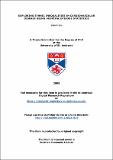Files in this item
Exploring ethnic inequalities in cardiovascular disease using Hospital Episode Statistics
Item metadata
| dc.contributor.advisor | Flowerdew, Robin | |
| dc.contributor.advisor | Dibben, Chris | |
| dc.contributor.author | Liu, Lixun | |
| dc.coverage.spatial | 363 | en_US |
| dc.date.accessioned | 2009-11-30T15:35:16Z | |
| dc.date.available | 2009-11-30T15:35:16Z | |
| dc.date.issued | 2009-06-11 | |
| dc.identifier.uri | https://hdl.handle.net/10023/819 | |
| dc.description.abstract | This thesis is based on a population study conducted to explore ethnic inequalities in cardiovascular disease using Hospital Episode Statistics (HES). The Hospital Episode Statistics have significant potential for health studies for ethnic groups, due to the large number of events from minority ethnic groups, comprehensive clinical information, full England coverage and fine geographical scale. However, the percentage of Finished Consultant Episodes (FCEs) with invalid ethnicity codes is at a high level. This thesis starts by developing a record linkage method and a coding rate method to improve the data quality of ethnicity codes in the HES. This thesis then further examines ethnic inequalities in cardiovascular disease incidence in England at both national and local geographical scales. The patterns of ethnic inequalities in cardiovascular disease appear to have changed little in the last ten years. However, large variations of geographical relative risk of cardiovascular disease were observed for ethnicity-sex groups. The relationships between areal socioeconomic status measured at different geographical scales and ethnic inequalities in different types of cardiovascular disease were also explored. As there are very limited data on the mortality of minority ethnic groups in the UK, few studies have compared the incidence and outcome of cardiovascular disease from the same population. This thesis came up with some novel findings, for example, that people from minority ethnic groups, who generally have increased risk of cardiovascular disease incidence, have better cardiovascular disease survival than white people. The contribution of areal socioeconomic status, distance to treatment sites and cardiovascular disease severity and treatment to the ethnic inequalities in cardiovascular survival was examined. The relationships between socioeconomic status measured at different geographical scales and ethnic inequalities in cardiovascular disease severity and treatment were investigated in this thesis as well. | en_US |
| dc.language.iso | en | en_US |
| dc.publisher | University of St Andrews | |
| dc.rights | Creative Commons Attribution-NonCommercial-NoDerivs 3.0 Unported | |
| dc.rights.uri | http://creativecommons.org/licenses/by-nc-nd/3.0/ | |
| dc.subject | Health geography | en_US |
| dc.subject | Ethnicity | en_US |
| dc.subject | Hospital Episode Statistics | en_US |
| dc.subject | Cardiovascular disease | en_US |
| dc.subject.lcc | RA645.C34L5 | |
| dc.subject.lcsh | Cardiovascular system--Diseases--Epidemiology | en |
| dc.subject.lcsh | Cardiovascular system--Diseases--Great Britain--Statistics | en |
| dc.subject.lcsh | Ethnicity--Health aspects--Great Britain | en |
| dc.subject.lcsh | Ethnic groups--Medical care--Great Britain | en |
| dc.title | Exploring ethnic inequalities in cardiovascular disease using Hospital Episode Statistics | en_US |
| dc.type | Thesis | en_US |
| dc.type.qualificationlevel | Doctoral | en_US |
| dc.type.qualificationname | PhD Doctor of Philosophy | en_US |
| dc.publisher.institution | The University of St Andrews | en_US |
This item appears in the following Collection(s)
Except where otherwise noted within the work, this item's licence for re-use is described as Creative Commons Attribution-NonCommercial-NoDerivs 3.0 Unported
Items in the St Andrews Research Repository are protected by copyright, with all rights reserved, unless otherwise indicated.


